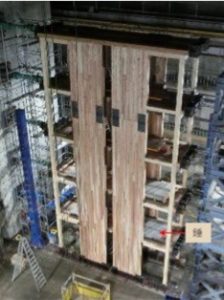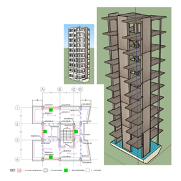2020 Activity Report for Mission 4: Development and Utilization of Wood-based Sustainable Materials in Harmony with the Human Living Environment
Updated: 2021/04/28
Award
18th Architecture and Society Award
【Winner】Hiroshi Isoda
【Awarding Organization】 Architectural Association of Japan
【Date】October 2020
【Contribution】Trends and future possibilities surrounding timber structures
71st Annual Meeting of Japan Wood Research Society “Best Student Oral Presentation Award”
【Winner】Takuya Tanji
【Awarding Organization】 Japan Wood Research Society
【Date】March 2021
【Contribution】Surface Structural controlling and Improvement in wettability of cellulose nanofiber sheets using imprint method
Research 1: Innovation of timber structure
Principal Investigator (PI): Hiroshi Isoda (RISH, Kyoto University)
Research collaborator(s): Takafumi Nakagawa (RISH, Kyoto University), Takuro Mori (Hiroshima University), Akihisa Kitamori (Osaka Sangyo University), Yasuhiro Araki (National Institute for Land and Infrastructure Management), Shoich Nakashima(Building Research Institute)
Based on the research for mechanical characteristics of new wooden materials such as cross laminated timber (CLT), we will develop new timber joints and construction system, and evaluate its structural performance which will contribute to the establishment of a sustainable society. We will also promote research on the composite structural members and buildings that combine wooden materials and wooden structures with other materials and structures in order to propose new developments in the use of wood.
Real-sized static loading test for coupled shear wall 5 story structure using CLT continuous wall with damping system have been carried out to evaluate seismic performance. The preliminary numerical analysis for real-sized 10 story shaking table specimen using CLT continuous wall rocking system have been carried out in cooperation with NEHRI Tallwood project in United States.
|
|
Publications, etc.
- Kotaro Sumida, Daiki Kinugasa, Takuro Mori, Takafumi Nakagawa, Yasuhiro Araki, Shoichi Nakashima, Akihisa Kitamori, Hiroshi Isoda, Full-scale static loading tests of cross-laminated timber shear walls with replaceable dampers used in balloon framing configuration Part.1, Outline of the tests and destruction status after loading, Summaries of Technical Papers of Annual Meeting, (2020)
- Daiki Kinugasa, Kotaro Sumida, Takuro Mori, Takafumi Nakagawa, Yasuhiro Araki, Shoichi Nakashima, Akihisa Kitamori, Hiroshi Isoda, Full-scale static loading tests of cross-laminated timber shear walls with replaceable dampers used in balloon framing configuration Part.2 Design of Joint and comparison between analytical model and test results, Summaries of Technical Papers of Annual Meeting, (2020)
Research 2: Quantitative morphology of woody plants
Principal Investigator (PI): Tomoya Imai (RISH, Kyoto University)
Research collaborator(s): Suyako Tazuru (RISH, Kyoto University),
Anatomical inspection is a conventional and reliable way for wood identification with regard to the species. However, there are some difficult cases of species identification only by anatomical inspection. One of such cases is distinguishing between Chamaecyparis obtusa (Hinoki) and Thujopsis dolabrata (Asunaro). This year, we have tested DNA barcoding analysis for the sample collected at Chio-In temple in Kyoto, which was identified as T. dolabrata. This sample has been used for more than 100 years as a building material in fact, but DNA amplification in an optimized condition was possible with high reproducibility. It is then shown that DNA barcoding is feasible enough for aged wood. Currently we are further optimizing the protocol for obtaining DNA-sequencing data reliable enough for species identification.
Research 3: Exploration of the innate function of wood for development of novel wood-based materials
Principal Investigator (PI): Kenji Umemura (RISH, Kyoto University)
Research collaborator(s): Daisuke Ando (RISH, Kyoto University), Miyuki Nakagwa (the Ehime Forestry Research Center
The innate function of nitrogen dioxide sorption of cedar wood has been explored. When using cedar wood, artificial drying treatment is often caried out, and the quantity and quality of the extracted components change depending on the treatment temperature. Therefore, the amount of nitrogen dioxide in the heartwood that was natural drying or artificial drying at various temperatures was examined. As a result, the nitrogen dioxide sorption was recognized regardless of the treatment temperature, but natural drying specimen had the largest amount of nitrogen dioxide. When the extracted components were removed from the dried specimens by solvent extraction, almost the same amount of nitrogen dioxide sorption was shown regardless of the drying conditions. The relationship between the content of the extracted components and the amount of nitrogen dioxide sorption had a high correlation. Therefore, it was clarified that the nitrogen dioxide sorption function is greatly affected by the amount of extracted components. Furthermore, as a result of analyzing the extracted components, it was suggested that avietadiene may contribute to nitrogen dioxide sorption.
Publication
- Miyuki Nakagawa, Kenji Umemura, Shuichi Kawai and Kozo Kanayama; Influence of drying temperature on NO2 sorption ability of cedar timber, J Wood Sci (2020) 66:30, DOI: 10.1186/s10086-020-01877-0
Research 4: Establishment of environmentally harmonized innovative recycling system of resources in the humanosphere
Principal Investigator (PI): Tsuyoshi Yoshimura (RISH, Kyoto University)
Research collaborator(s): Toshimitsu Hata (RISH, Kyoto University)
Our research targets are a) to enhance the durability of wood-based materials based on fundamental researches, and b) to research and develop sustainable functional materials from wood. The present research topics are as follows:
-
- The general survey of invasive dry-wood pests
The expanding if global trading of wood and wood-based materils has been resulting in the invasion of the exotic dry-wood pests, such as Bostrychidae and Lyctidae from tropics, From this point of view. we made a survey of a cargo and a warehouse of imported plywood. AS a result, 32 biological samples were obtained and they were under identifications. Tentatively, sone dry-wood pests are included, - Pore structure analysis of CO2 adsorbed carbon
In order to apply the CO2 adsorbed carbon to biochar, the effect of heat treatment conditions on the nanopore structure was investigated by CO2 adsorption measurements. Non-Local Density Functional Theory analysis of the obtained adsorption isotherms showed that the surface area at 600°C was larger than that at 800°C. The phase behavior of CO2 gas trapped in the micropores was more accurately determined by the NLDFT method, and the detailed pore size distribution consisting mainly of micropores was revealed. The surface area was further increased by ball milling of the raw wood. By changing the heat treatment conditions, the micropore and chemical structures of the resulting porous carbons were changed, indicating the possibility of obtaining materials that efficiently adsorb CO2.
- The general survey of invasive dry-wood pests
Publications,etc.
- Toshimitsu Hata;Sensho Honma;Kyoichi Oshida:Effect of Heat Treatment and Activation Conditions on Microporous Structure of Woody Carbon, Abstracts of the 71st Annual Meeting of Japan Wood Research Society, Tokyo, March 2020.
Research 5: Production and utilization of cellulose nanofibers
Principal Investigator (PI): Hiroyuki Yano (RISH, Kyoto University)
Research collaborator(s): Kentaro Abe, Soichi Tanaka (RISH, Kyoto University)
Cellulose nanofibers (CNFs) are a fundamental component of plant cell walls. Because of their excellent mechanical properties and their high specific surface area, we are studying the utilization of CNFs as a reinforcing filler of resin composites.
In many cases, it is necessary to modify the raw CNFs to obtain a balance between hydrophilic and hydrophobic properties, introduce functional groups, dewater, and re-disperse. Polymer grafting on the surfaces of CNFs is a particularly powerful means of guiding self-assembly and tuning the compatibility of CNFs with other materials. However, large quantities of organic solvent are used in pre-treatment, polymerization, and/or purification, which is environmentally unfriendly. Therefore, there is a demand for new polymer grafting methods that are both facile and green.
In our study, we irradiated an aqueous suspension of CNFs with ultraviolet (UV) light to generate radicals on the sur- faces of the CNFs, initiating polymer grafting. As a result, poly (methyl methacrylate) (PMMA) was readily grafted from the CNFs, without destroying the crystalline region of cellulose. PMMA-grafted CNFs show improved hydrophobicity and redispersibility in organic solvent. As well as PMMA, various other polymers can be grafted from CNFs without using organic solvents. We believe that this technique, called UV grafting, may provide a greener method for producing CNF materials with novel features.
Publications, etc.
- Ishikura Y, Yano H. Microfibrillated-cellulose-reinforced polyester nanocomposites prepared by filtration and hot pressing: Bending properties and three-dimensional formability, Journal of Applied Polymer Science 137 (33), 48192, 2020
- Tanpichai S, Biswas SK, Witayakran S, Yano H. Optically transparent tough nanocomposites with a hierarchical structure of cellulose nanofiber networks prepared by the Pickering emulsion method, Composites Part A: Applied Science and Manufacturing 132, 105811, 2020







